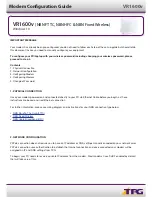
CHAPTER 2
System Setup
28
the earth, on flat terrain, the maximum distance which can be
reached depends on the height above ground of the antennas of
the transceivers of the Base Station and of the measuring stations.
You can't do much on the remote station side, but you have more
options with the Base Station. Some typical examples of distances
achieved under various conditions are shown in Table 1.
The addIT RTU, however, uses low-power technology and was not
designed to communicate over large distances. The typical "line-
of-sight" distance an addIT can communicate is 800 m (approxi-
mately half a mile). This is valid if the partner device is mounted on
a 3 m mast (9 ft) and the addIT is mounted on a 30 cm mast (1 ft).
The above figures are estimates based on a great deal of experi-
ence with installing this kind of equipment and assume a typical
height of 3 m (9 ft) for the antennas of the remote measuring sta-
tions. Similarly, ideal physical conditions are assumed for the ter-
rain including a flat, open, non-urban environment.
Table 1. Communication between Base Station and RTUs A730MD/
A733/A740
What conclusions can be drawn from Table 1? Primarily, you can
see the importance of having the Base Station antenna as high as
possible. To gain antenna height, you have several options:
•
Build a mast directly on the ground; however, a 30 m (100 ft)
mast may not be a practical option.
•
Set up a mast on a tall building (of course, it has to be the
building where you want to have the Base Station).
•
Install the Base Station in a building that is situated on a hill.
Receiving antenna
height
Typical distances
achieved
6 m (18 ft)
5 km (3 miles)
10 m (31 ft)
8 km (5 miles)
20 m (62 ft)
16 km (10 miles)
30 m (92 ft)
24 km (15 miles)
Summary of Contents for A850
Page 92: ...CHAPTER 3 Configuring the Gateway 92 Figure 81 PPP Configuration Window ...
Page 128: ...CHAPTER 3 Configuring the Gateway 128 Figure 132 Dialup Modem Window ...
Page 164: ...CHAPTER 3 Configuring the Gateway 164 ...
Page 177: ...CHAPTER 4 Sensor Type Configuration 177 Figure 183 Sensor type Window Analog ...
Page 196: ...CHAPTER 4 Using the Gateway 196 Figure 216 Sensor type Window LC ...
Page 200: ...CHAPTER 4 Using the Gateway 200 Figure 222 Sensor type Window OC ...
Page 204: ...CHAPTER 4 Using the Gateway 204 Figure 228 Sensor type Window SDI ...
Page 215: ...CHAPTER 4 Logs 215 Figure 241 System Log Selection Log types Figure 242 System Log Log types ...
Page 275: ...CHAPTER 4 RTU Network Configuration 275 Sensor details Figure 319 Sensor details Window ...
Page 366: ...CHAPTER 6 Appendix 366 ...
















































